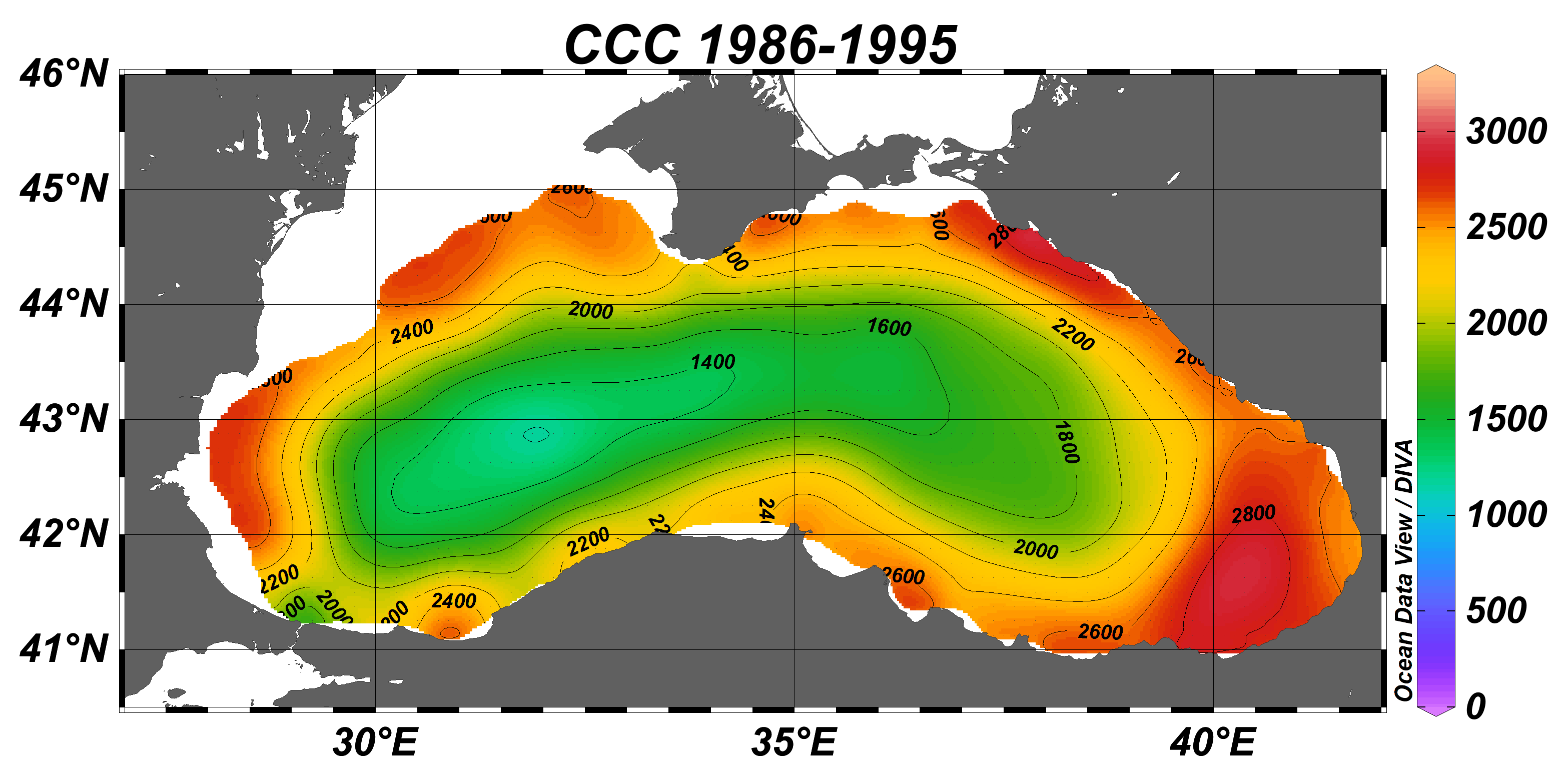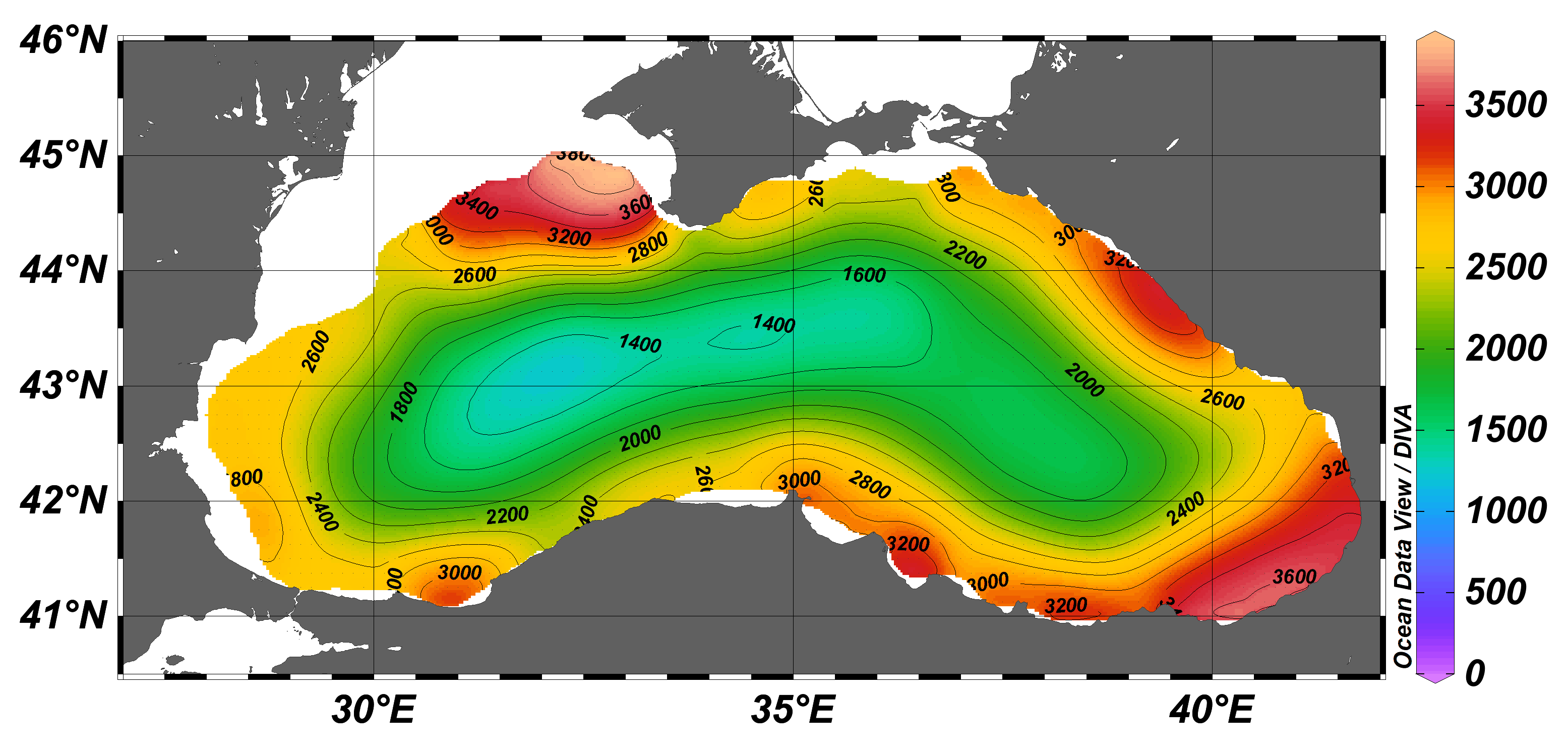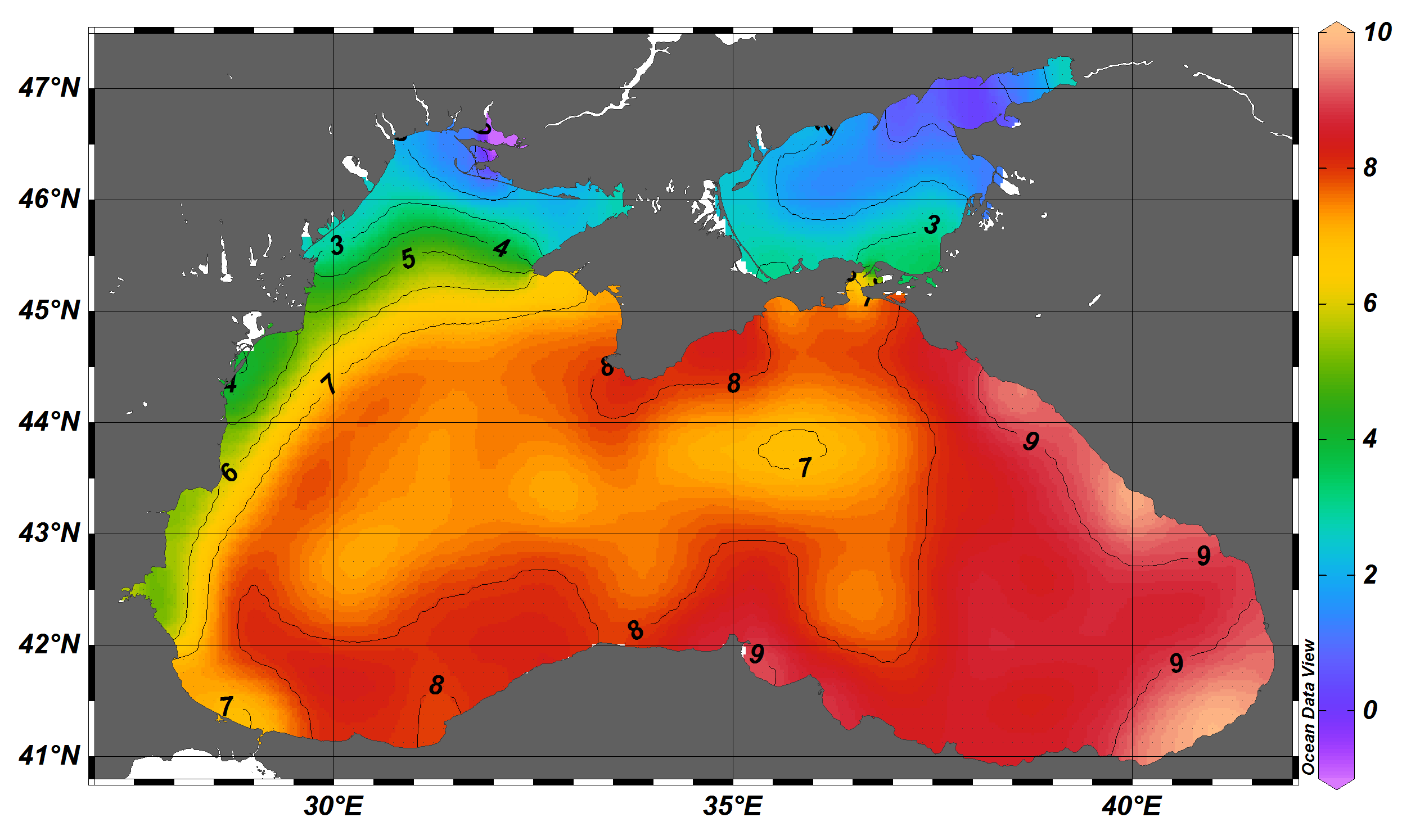Black Sea
Type of resources
Available actions
Topics
INSPIRE themes
Keywords
Contact for the resource
Provided by
Years
Formats
Representation types
Update frequencies
Scale
Resolution
-

Black Sea gridded decadal annual climatology for cold intermediate layer (CIL) cold content (CCC) (1/8°, 56 sliding decades) based on the collection of temperature and salinity profiles spanning 65 years (1955–2019).The CCC climatological fields were computed from the merged Black Sea dataset that combines data extracted from 3 major sources: 1) SeaDataNet infrastructure, 2) World Ocean Database, and 3) Coriolis Ocean Dataset for Reanalysis. The computation was done with the DIVAnd (Data-Interpolating Variational Analysis in n dimensions), version 2.6.2. The product was developed in framework of SeaDataCloud project, EC H2020 grant #730960. For data access please register at http://www.marine-id.org/.
-

The Black Sea gridded monthly climatology for cold intermediate layer (CIL) cold content (CCC) (1/8°, 12 months) based on the collection of temperature and salinity profiles spanning 35 years (1955–1999).The CCC climatological fields were computed from the merged Black Sea dataset that combines data extracted from 3 major sources: 1) SeaDataNet infrastructure, 2) World Ocean Database, and 3) Coriolis Ocean Dataset for Reanalysis. The computation was done with the DIVAnd (Data-Interpolating Variational Analysis in n dimensions), version 2.6.2. The product was developed in framework of SeaDataCloud project, EC H2020 grant #730960. For data access please register at http://www.marine-id.org/.
-

Black Sea gridded decadal seasonal climatology for cold intermediate layer (CIL) cold content (CCC) (1/8°, 6 decades, 4 seasons) based on the collection of temperature and salinity profiles spanning 60 years (1955–2014).The CCC climatological fields were computed from the merged Black Sea dataset that combines data extracted from 3 major sources: 1) SeaDataNet infrastructure, 2) World Ocean Database, and 3) Coriolis Ocean Dataset for Reanalysis. The computation was done with the DIVAnd (Data-Interpolating Variational Analysis in n dimensions), version 2.6.2. The product was developed in framework of SeaDataCloud project, EC H2020 grant #730960. For data access please register at http://www.marine-id.org/.
-

Gridded product for visualization of Water body phosphate in the Black Sea generated by DIVA 4.6.9 using all EMODNET Chemistry data from 1960 to 2013. Depth range (IODE standard depths): 0 – 200m. DIVA settings: signal-to-noise ratio and correlation length were estimated using data mean distance as a minimum (for L), and both parameters vertically filtered. Background field: the data mean value is subtracted from the data. Detrending of data: no. Advection constraint applied: no. Every year of the time dimension corresponds to a 10-year centred average for each season: - winter: December - February, - spring: March - May, - summer: June - August, - autumn: September – November Units: umol/l
-
Moving 6-year analysis of Water_body_silicate in the Black Sea for each season: spring (March-May), summer (June-August), autumn (September-November), winter (December-February). Every year of the time dimension corresponds to the 6-years centred average of each season. 6-years periods span: from 1970-1975 until 2013-2018 Depth range (IODE standard depths): -200.0, -150.0, -125.0, -100.0, -75.0, -50.0,-40.0, -30.0, -20.0, -10.0, -5.0, -0.0. Data Sources: observational data from SeaDataNet/EMODnet Chemistry Data Network. Description of DIVA analysis: Geostatistical data analysis by DIVA (Data-Interpolating Variational Analysis) tool. GEBCO 1min topography is used for the contouring preparation. Analysed field masked using relative error threshold 0.3 and 0.5 DIVA settings: signal-to-noise ratio and correlation length were estimated using data mean distance as a minimum (for L) and vertically filtered. Log transformation was used in the analyses. Background field: the data mean value is subtracted from the data. Detrending of data: no, Advection constraint applied: no. Units: umol/l. The entire set of related maps can be found in the viewing service: http://ec.oceanbrowser.net/emodnet/
-

The SDC_BLS_CLIM_TS_V1 product contains Temperature and Salinity Climatologies for Black Sea including the seasonal and monthly fields for period 1955-2017 and seasonal fields for 6 decades starting from 1955 to 2014. The climatic fields were computed from the integrated Black Sea dataset that combines data extracted from the 3 major sources: 1) SeaDataNet infrastructure, 2) World Ocean Database 2018, and 3) Coriolis Ocean Dataset for Reanalysis. The computation was done with the DIVAnd (Data-Interpolating Variational Analysis in n dimensions), version 2.3.1.
-
Water body dissolved inorganic nitrogen (DIN) - - Seasonal Climatology for Danube Delta (NW Black Sea) for the period 1980-2018 on the domain: Lon E28.5-30.5°E, Lat N43.7-45.6°N. (winter: December-February, - spring: March-May, - summer: June-August, - autumn: September-November). Data Sources: observational data from SeaDataNet/EMODNet Chemistry Data Network. Description of DIVA analysis: The computation was done with the DIVAnd (Data-Interpolating Variational Analysis in n dimensions), version 2.7.5, using GEBCO 30sec topography for the spatial connectivity of water masses. Horizontal correlation length of 47.730km and vertical correlation length of 45m were applied. Depth range: 0, 2.0, 4.0, 6.0, 8.0, 10.0, 15.0, 20.0, 25.0, 30.0, 40.0, 50.0. Units: umol/l. The horizontal resolution of the produced DIVAnd maps grids is 0.01 degrees.
-
Water body chlorophyll-a - Seasonal Climatology for Danube Delta (NW Black Sea) for the period 2001-2018 on the domain: Lon E28.5-30.5°E, Lat N43.7-45.6°N. (winter: December-February, - spring: March-May, - summer: June-August, - autumn: September-November) Data Sources: observational data from SeaDataNet/EMODNet Chemistry Data Network. Description of DIVA analysis: The computation was done with the DIVAnd (Data-Interpolating Variational Analysis in n dimensions), version 2.7.5, using GEBCO 30sec topography for the spatial connectivity of water masses. Horizontal correlation length of 47.730km and vertical correlation length of 45m were applied. Depth range: 0, 2.0, 4.0, 6.0, 8.0, 10.0, 15.0, 20.0, 25.0, 30.0 m. Units: mg/m^3. The horizontal resolution of the produced DIVAnd maps grids is 0.01 degrees.
-
Moving 6-year analysis of Water_body_dissolved_inorganic_nitrogen_(DIN) in the Black Sea.for each season: spring (March-May), summer (June-August), autumn (September-November), winter (December-February). Every year of the time dimension corresponds to the 6-years centred average of each season. 6-years periods span: - from 1990-1995 until 2013-2018 (spring), - from 1990-1995 until 2013-2018 (summer), - from 1990-1995 until 2013-2018 (autumn), - from 1990-1995 until 2011-2016 (winter). Depth range (IODE standard depths): -100.0, -75.0, -50.0,-40.0, -30.0, -20.0, -10.0, -5.0, -0.0. Data Sources: observational data from SeaDataNet/EMODnet Chemistry Data Network. Description of DIVA analysis: Geostatistical data analysis by DIVA (Data-Interpolating Variational Analysis) tool. GEBCO 1min topography is used for the contouring preparation. Analysed field masked using relative error threshold 0.3 and 0.5 DIVA settings: signal-to-noise ratio and correlation length were estimated using data mean distance as a minimum (for L) and vertically filtered. Background field: the data mean value is subtracted from the data. Detrending of data: no, Advection constraint applied: no. Units: umol/l. The entire set of related maps can be found in the viewing service: http://ec.oceanbrowser.net/emodnet/ .
-
Moving 6-year analysis of Water_body_phosphate in the Black Sea for each season: spring (March-May), summer (June-August), autumn (September-November), winter (December-February). Every year of the time dimension corresponds to the 6-years centred average of each season. 6-years periods span: from 1970-1975 until 2013-2018 Depth range (IODE standard depths): -200.0, -150.0, -125.0, -100.0, -75.0, -50.0,-40.0, -30.0, -20.0, -10.0, -5.0, -0.0. Data Sources: observational data from SeaDataNet/EMODnet Chemistry Data Network. Description of DIVA analysis: Geostatistical data analysis by DIVA (Data-Interpolating Variational Analysis) tool. GEBCO 1min topography is used for the contouring preparation. Analysed field masked using relative error threshold 0.3 and 0.5 DIVA settings: signal-to-noise ratio and correlation length were estimated using data mean distance as a minimum (for L) and vertically filtered. Log transformation was used in the analyses. Background field: the data mean value is subtracted from the data. Detrending of data: no, Advection constraint applied: no. Units: umol/l. The entire set of related maps can be found in the viewing service: http://ec.oceanbrowser.net/emodnet/
 Metadata catalogue
Metadata catalogue